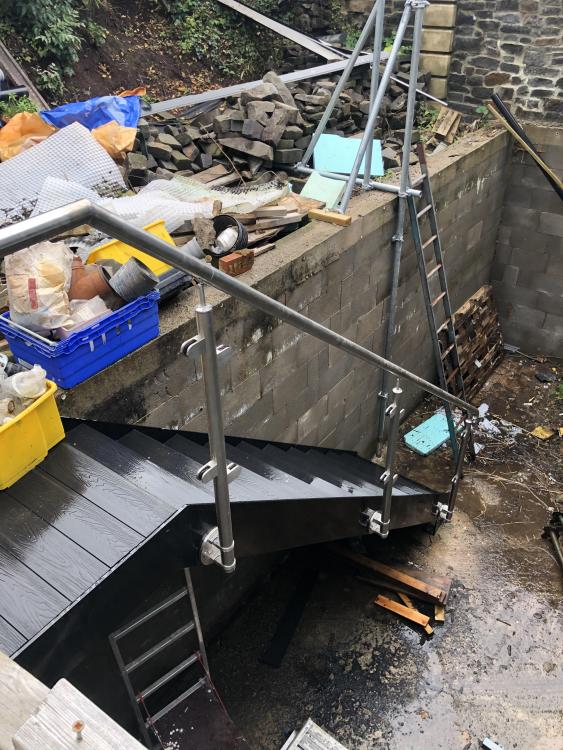Leaderboard
Popular Content
Showing content with the highest reputation on 10/26/21 in all areas
-
3 points
-
2 points
-
2 points
-
Differential settlement, reducing the height of any tanking membrane and connecting the inner wall DPCs to the DPM. Speak to your local Visqueen representative - he/she will do you a site specific detail. Don’t forget about radon if you are in a radon area.1 point
-
Batt insulation, sprayfoam or blown up in. Followed by a membrane and insulated service cavity Life is too short.1 point
-
1 point
-
I would not invite them to list the evidence you want, because you will probably only fall short. Rather, I would provide ALL contemporaneous documents you can gather, by which I mean documents that came into existence more than four years ago which in some way evidence your construction of the thing. I would supply that and say: as you can see from the enclosed copies of documents (don’t provide originals), the building was built in [whatever year you actually built it], which is more than 4 years ago and accordingly the Council has lost any right to take enforcement action. i would then see what happens. They may back down. If they don’t, at that stage I would start to gather actual witness statements.1 point
-
Except that a specialist has thousands of hours of experience. How many hours’ underpinning experience do you have?1 point
-
1 point
-
This has 2018 photos for my area.. https://www1.getmapping.com/webshop/web/commonpages/main/preview.aspx?srid=27700&x=295040&y=668480&width=500&height=5001 point
-
I guess you tried this on Google maps.. https://medium.com/@thegeospatialnews/how-to-get-old-satellite-images-on-google-maps-f11b2fad17b41 point
-
Our window company said to slate the roof first to ensure it’s fully loaded before installing windows. So that’s what we’re doing. Roofer starts in 2 weeks!1 point
-
1 point
-
An ordinary 25mm cavity has a thermal resistance of 0.18m2.K/W, a cavity with a low emissivity surface 0.44m2.K/W. (possibly the foil layer of the PIR) a cavity with 25mm of rockwool, thermal conductivity 0.035W/m.K will have a thermal resistance of 25/35 m2.K/W or 0.71m2.K/W Solid walls with a core of rubble fill do have a better than expected thermal resistance, typically 1.0m2.K/W When finished with plaster, pageV Mortar has a thermal conductivity of about 0.9W/m.K whilde granite is about 2.8W/m.K so I do not think so. hstp102011-u-values-and-traditional-buildings.pdf1 point
-
We used Conzio 60 tape around windows and air tight paint along the wallplate. We're also using air tight adhesive render beads on the outside of the frames, plus exterior water proof tape for the door blocks under the door frames on the outside.1 point
-
1 point
-
After putting big panes in with a crane and suckers, or one of our guys grinding near a pane we used white scotchbrite pads to polish any marks out1 point
-
Backdraft shutter on the kitchen hood. No fan in the bathroom yet ... we just open the window. Bathroom reno is still on the to-do list!1 point
-
The Johnson & Starley warm air boilers modulate the heat output - they don't work on a traditional "on/off" thermostat, but rather one that provides a resistance that varies proportional to the room temperature. The boiler will start up in the morning on full, then start to back off the output temperature, then keep the fan running longer, and then just end up "blipping" every couple of minutes at low output to maintain the temperature. So it probably us in fully condensing mode by that time. I hadn't heard of skirt or wing insulation ... might have been worth doing before we had our patio renewed! No chance now though. No heat recovery. There's no backdraft shutter on the combustion air - you couldn't do that as it would affect the ability to pull enough air through (as confirmed by our heating engineer). But that's not an issue now the combustion air goes directly into the boiler cupboard. The heating mainly recirculates air - there's air-return vents in the lounge, hallway and landing.1 point
-
1 point
-
Yes ... but that would only supply one room at a time and is quite ugly/industrial looking. We didn't go with the garage conversion in the end but extended the kitchen instead. We just used a 2kW thermostatically-controlled wall-mounted electric heater as a top-up for the extra space. It's only on for a couple of hours in the morning and evening, and the thermostat keeps the on-time low.1 point
-
Add just enough heat to the inside of the structure to prevent condensation.1 point
-
Just a quick update now data is growing a couple of charts showing average cost per day V's night temps and one that inc kWh's used. General observation - still very efficient overall running costs now average £0.89p per day (up from 79p/day) pellets would have averaged at 3x this cost so very pleased.1 point
-
You need them in as soon as possible after the TF erection is completed. Any delay can delay your airtightness test because the build needs to be wind and watertight before that. We ordered from the plans - although having said that, they were the plans from the architect. MBC designed the frame based on the structural openings in the architect's plans and these were what we signed off on. They are then contractually obliged to build to the signed off spec. If they don't, they have to fix it. What this means is that you have to juggle the lead times of the windows people with the information you are getting from MBC about their start date on site and likely completion date. For us the windows had 10 week lead time, so they were ordered as soon as we had the dates from MBC. Unfortunately like some others on here, we received an email from MBC about 10 days before the build start date that unfortunately they had had an issue with wood deliveries and they couldn't start until 4 weeks after the original date. That's when the fun started. The rooflight company wanted a stupid amount of money for storing the rooflights after the agreed delivery date, so we could only delay them by a week. The plan was that MBC would start on the garage and it would be up and completed by the end of the 1st week of the build. Unfortunately the steels didn't arrive, so there was nowhere to store the rooflights safely - we have found a safe spot now. The garage is likely to be the last thing completed... With the windows, it depends on the supplier and whether they are doing the install. If they are doing the install as well - which is our case - then if there is no slack in their overall installation program, then you may find you are at the back of the queue again with a long delay. We were fortunate in that they could delay us by a month. MBC should finish the build this Friday (yee haaaa) and the windows will be delivered and installed on Monday week, so 10 days after MBC finish. To give you some reassurance, I went over all the structural openings with the architect last weekend checking the measurements. They are all within a few mm of the spec and don't forget that the window manufacturers all allow for some tolerance of up to 10mm, these things aren't a friction fit. Simon1 point
-
I found the Geberit instructions confusing to start with, what with their mixing mm and cm. Once you crack the code so to speak and it's crystal clear. I've fitted a Geberit wall frame and wall drain now and tbh love the stuff. I found the videos really helped. Just YouTube "Geberit UP320".1 point
-
What a lovely project. It's nice to see old buildings being looked after. I would probably stick at 400mm centers as it is much easier to fix. Just set your sole plate. Cut your verticals roughly to length. Tie a string in the right place, nail the top horizontally to the rafter, get a mate with a level to toe nail the bottom. Job done. To save cost, drop from 140*45 studs to 88*38 CLS. Doing anything too clever with 600mm centres will probably only increase labour I suspect. I have potentially a similar project somewhere in my distant future. I would like to set my stud wall at least 50mm back from the outside stone wall, put a an airtight layer inboard of the studs and blow eps beads between the studs and between the studs the wall. Then counterbatten 45*45 with 50mm batt insulation and plasterboard. Can anyone see any issue with this?1 point
-
1 point
-
1 point
-
Update: we had a neighbour pop round yesterday who is a joiner. He took one look at our external noggins, and started into one of those Harry Enfield sketches "You don't wanna do it like THAT: You wanna do it like THIS". He pointed to one of the noggins, declaring it cracked, and wacked the thing right off! Then walked around the building questioning my building choices in a way that was probably enormously helpful, but given that we have almost finished, didn't feel all that helpful..... The upshot of that rather dispiriting lecture on my half-arsed building skills was that he explained that we should cut off our external noggins (can't remove them as they are well and truly fixed on), and replace them with a gable ladder at the front and back, as suggested by @SimonD above. This actually solves the issue of the asymmetric soffit level, and in turn the difficulty of sourcing 350mm fascia (which has been unavailable at most suppliers). He also pointed us towards a local plastics company that does all of the roofing products we were looking for, available for delivery tomorrow, and at about 60% of the price we were being quoted online, so that was a massive win. Every cloud...1 point
-
@saveasteading - 140x38 stud. Lintels are 225x50 x3. OSB on the inside to give me a good working surface to VCL, service void/batten out. Gutex board is currently fixed in place with 2 or 3 thermally broken screws Ejotherm STRH, these aren't structural. On top of this will go the breather membrane tapped for windtightness. This is all held back to the timber frame with 38x50 treated battens using Heco screws (Heco provide a fixing design but they were ££££). Cladding on top. ?1 point
-
if i was a betting man i would say that frame is (6x2) 138x38mm CLS with a 140mm insulation, which is the most used size up here usually with 50mm PIR on the inside and timber cladding on the outside1 point
-
If hinged as above wouldn’t add silicone, some form of silicone trim slid on to the glass is usually the normal. Regards. James1 point
-
I would just fit a conventional good quality one unless you end up with extract only ventilation. There'll be plenty of air in your house to feed the stove. No need to put in more holes. It does help. I'll try to show with some Therm simulations adapting my own 250mm eps cavity wall. An approximation of external wall insulation only. Total interior U value 0.49. Now with 200mm EPS in the floor. U value drops to 0.3 but still lots of heat escapes via the corner if insulation is not carried down. Bearing in mind this is with a wall U value of about 0.13 and a floor of 0.16 so the effect of the thermal bridge is dramatic. Look what happens when we carry the insulation 700 mm below floor level. U value drops to 0.2. A big improvement. The same but with floor insulation removed. U Value back to 0.34. Next I've added 1m of 100mm EPS horizontally. The floor U Value is now the same as with just the 200mm floor insulation and nothing externally below ground. (this is a simplistic example so they wouldn't perform the same in reality. BTW I've also accidentally removed the outer leaf here but it makes little difference) Finally I've done all I can to avoid digging the floor, Externally insulated with 250mm EPS 700mm below the ground. Included a 1m wing and added 25mm of EPS above the floor to take the underfloor heating pipes. U value is 0.27 overall. I'm going to make a crude estimation and say this is the equivalent of putting 250mm EPS in your floor and not taking any measures against the wall/floor junction. The lesson of all this is 2 fold, firstly if you can't or really don't want to dig up your floor there are other options. Secondly insulation is of limited use without getting a handle on thermal bridges. If you search for "french drain" I did some posts recently about them. I think everyone should have one. It'll be a pain with the insulation already installed and if you put in batt or roll insulation you'll never fix it right again after putting in the ducts. Hope this helps.1 point
-
If any works are carried out without the relevant approvals, then that will of course open you up to issues in the future, especially the health and safety of those that reside and use dwellings. Say goodbye to any sort of insurances should the worst happen.1 point
-
A Building Regulations application will be required for the works irrespective of when it was carried out. It’s called unauthorised works and it always comes out in the wash. Don’t hide it - get proper advice from your local BCO.1 point
-
There are three aspects to how the air part of an ASHP work. One is the relative difference between the cold side of the HP and the external air. Two is the amount of air moved. Three is the chances of the external radiator frosting/freezing up, that is related to humidity. The amount of specific energy in air is pretty fixed at the temperatures they work at in the UK (there is a slight drop as the temperature drops, but not much, about 0.8PPM over 60K https://www.engineeringtoolbox.com/air-specific-heat-capacity-d_705.html). What can happen is the if the ASHP is running at close to full capacity when highly water saturated air hits the cold side, it can freeze, this both impedes the airflow and insulated the fins. This is why there is a defrost system built in. This uses little energy in the scheme of things, so not worth worrying about in a correctly sized system. The most likely temperature to cause freezing is not 0°C (273.2K), but ~4°C as this is when water is at its most dense, so there is more to condense out than at 0°C or below. As @Iceverge points out, they shift a lot of air, so location i.e. sun or shade, makes no real difference. Fit them where there is good airflow and the external pipework/wiring is short. Don't try to run an ASHP at its highest rated temperature, that is like driving a car at top speed all the time, it will end in problems (I suspect a gas or oil boiler would break, if it was run 24/7 at full rated power, fairly quickly). If you get into calculating thermal efficiencies, they stop using the celsius scale and use the kelvin scale, the kelvin scale is a truer model of the kinetic energy of air molecules, and there is no minus temperatures to fool you.1 point
-
Likewise i project managed our build, our builder was brilliant but like Jeremy found a couple of little issues that would have become bigger if not spotted at the time. My wife (who is bitter because she still works and I am retired!) said she could project manage our build but without building knowledge she would not necessarily see problems developing. I agree with Peter, a good PM with insurance is the way to go if you are not conversant with building yourself.1 point
-
As an aside I'm building in block so have no vested interest in TF one way or the other. I just so happen to be argumentative and stubborn ?so will throw out a counter argument if I disagree with something - no offence is ever intended though!?1 point
-
I think our opinions diverge here somewhat Jeremy. As a relatively new member of this forum there is a lot of information within these here walls about your supplier and I am left with the impression that these are big dogs in the TF world offering high performance houses at passive level standards and for a premium price. In addition there are a hell of a lot of glowing endorsements offered by others to support that view. To suggest otherwise seems a little disingenuous to me (just my opinion). I would challenge anyone to read this forum with a non partisan mindset and not come to the same conclusion. I certainly see them as offering "gold standard"....Huf Haus we will call "platinum"? It's amusing how this thread has exploded somewhat from its original theme - I have just finished reading a 2016 thread Jeremy which you may recall - about Actis? foil insulation (or as you said "snake oil" ?) Just goes to show that there were disagreements back then just as much as there are now! Free and healthy debate is always good, if I'm ever wrong then so be it...... I'm not very good at conceding defeat though so bear with me because it takes a while☺️1 point
-
There's talk of a "gold standard" here, which I think is wholly incorrect. The "gold standard" in terms of timber frame companies are people like Huf House, at around £4,000/m². A frame company that supplies and erects the foundation and frame for around £415/m² (which is around what ours cost) is, frankly, right at the budget end of high performance timber frame and foundation suppliers. They don't pretend to be anything other than what they are, and do need some project managing, as I and everyone else has learned. If you don't want to project manage, or employ and independent project manager that you know little about, then go for someone like Huf House, who will pretty much manage every aspect of the build. I'd just add that our house was built be the same company and all of their work is damned near flawless. Mind you, I was on site practically every day, even if only for an hour or so, just to make sure things were OK, and I did pick up a handful of things that only I, as PM, would have spotted, and so they never turned into problems as they were caught very early on.1 point
-
Thanks @lizzie - appreciate that update on what sounds like was a difficult time. Glad you are enjoying the new house though !1 point
-
Well i built brick and block, 1, I wanted a brick outside skin thatnneeds no maintenance as render needs painting and or can lead to cracking. 2, I have not reduced floor space I simply built my house with the rooms the size I required then added walls with cavities. 3, with good bricklayers I got air tight walls with wet plaster, (attention to detail at joins and no expensive tapes that may or may not last. ). 4, solid walls that I can hang anything on. Perhaps I am lucky that I had a good builder but they are out there you just need to do your homework ( and book them early as good ones are always very busy).1 point
-
It's a chalet bungalow that is 220sqm. I know i have a nice shiny sharp spade but I got a digger in for the founds. Yeah I worked continental shifts so got plenty of time of so basically worked every day for 2 full years with the only days off caused by rain , snow and frost and waiting in materials. I have to add that I had worked on building sites for over 15 years and gained a lot of knowledge and skills and contacts so knew what I was at.1 point
-
1 point
-
I’ll use an analogy that’s a bit closer to home for me since the worst you are going to get with a rubbish meal is something you don’t like or gives you a bad stomach afterwards. In an IT delivery sense you can take more of a risk with something non essential, such as adding a utility for example, so you can let someone quite junior do the work with little experience. At the other end of the scale with an IT change that puts billions of pounds of funds under management at risk for example, risk avoidance is paramount and takes on a whole different nature, so there is no way that a change of that criticality would be allocated to the same individual. They might well be able to do it but the risk would be too great to take. Most self builders don’t have endless pots of money to risk on getting things wrong and having to pay again, so containing the risk is all important. It doesn’t mean that there are never unexpected costs or issues of course, but TF provides some risk mitigation in my view even if it means paying a bit more for someone to carry some of that risk. Plus it’s quite a decent construction method too with a proven track record! And there are far less ‘experienced’ self builders than those who do this as a one off, once in a lifetime thing. If you are building multiple houses (ie more than 1 or 2), it surely moves you into the small developer category rather than self builder? And most self builders get pleasure from choosing the construction method, materials, design. It’s what makes it worth doing, so definitely not a simple Tesco vs Sainsbury’s choice for me. Anyone who feels like that about it probably shouldn’t do it in my view.1 point
-
It took me close on 9 months to build my block house by myself. I had no digger or telehandler so relied on £20 notes slipped to the driver to get the blocks where I needed them to be. It was a long back breaking 9 months that I would never ever repeat again for anyone or any amount of money. Don't underestimate the toll this has on your mind and body if you are going to go down this road. Its paying a disservice to the brickie that not everyone will do a good job. There are good ones and bad ones same way there are good joiners and plumbers and sparks and on the other hand there are guys who are so bad you wonder how they put food on the table, it's just how it is. Same with going out and buying a trowel, string line and lump hammer and a level and thinking after sticking 3 blocks together that you are a brickie. There is a lot more to it if you are thinking about building a complete house. The main reason for choosing blocks was finance. I simply had none. We used all our savings up cashed in my old endowment policy to get the house wind and water tight as I needed to sell my own house before I could get a mortgage. Each week we could buy a load of blocks and then over the next 2-3 weeks build away until they where done or I needed sand or cement and I just continued like this until one day it was built. My back, wrist and hands loved that day. I simply didn't have the amount of money that a timber frame company was looking up front to go that option. As far as sips or ICF all that was stuff I had only seen on grand designs and was way out of my comfort zone so deemed to much of a risk. Think the cheapest quote from a timber frame company was £55k to get it wind and water tight. I got it there for £32k by doing it myself. So to answer the original question what method is best , there just isn't one. Every one has its pros and cons and everyone of us starting out at the start of our builds weighed these all up and based on what each of us wanted and the availability of trades, materials ,finance and even site location and layout picked whatever one ticked the most boxes. P.s obviously blocks are better!!!1 point
-
When I decided to go with that system, we had an alternative kit quote from Deeside TF. Although they were cheaper for the same U values, all insulation would have to be fitted on site, and having worked out the time / cost of that, the Supawall wons hands down. Compared to previous kits where tolerances were very elastic, the Supawall kit was mm perfect. A lot of time went into ensuring the soleplate was fixed according to the critical frame dimensions, but when the kit arrived and was craned into place (we had one 10 metre panel) it went like clockwork. Simple quick and effective, with each piece sliding in and interlocking with the next. It certainly persuaded the contractor I was using that such systems were the way forward. It was the first time he had built with it, and had been a little reluctant, but having erected the frame in just over two hours, he came to me and said all houses should be built this way.1 point
-
Mine too, and it is the only experience I have but it went up to the watertight stage with almost frightening speed and we had no issues with fit. It was like building an Airfix kit!1 point
-
I'd opine that it depends on the size of the development. Locally, most recent builds in the 2-20 property region are TF; bigger estates seem more likely to be block.1 point
-
I feel the new entrant to self-build gets a biased view of the TF/B&B debate. The reason for the bias is that the 3-man brickie team in their tatty transit do not have a voice. The TF companies understand the media and how to influence the market. TF companies buy adverts in magazines and feed ready-made cut & paste narrative for free editorial coverage, they also buy space at industry shows. A prospective self builder should ask, why are so many block & block homes built in the face of such a one-sided debate.1 point

























